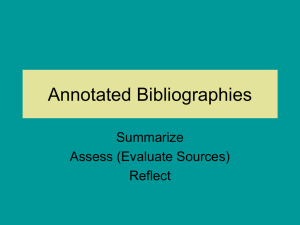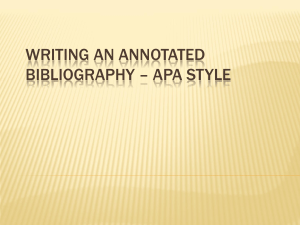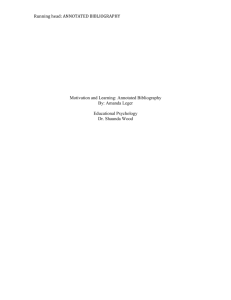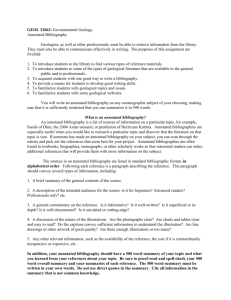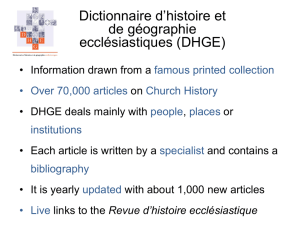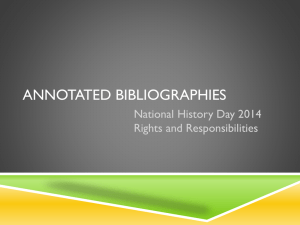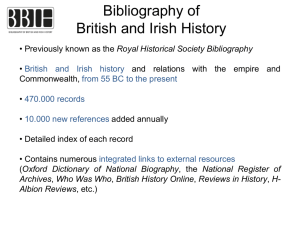Teacher-Resources-High-School-Level-Part-1
advertisement
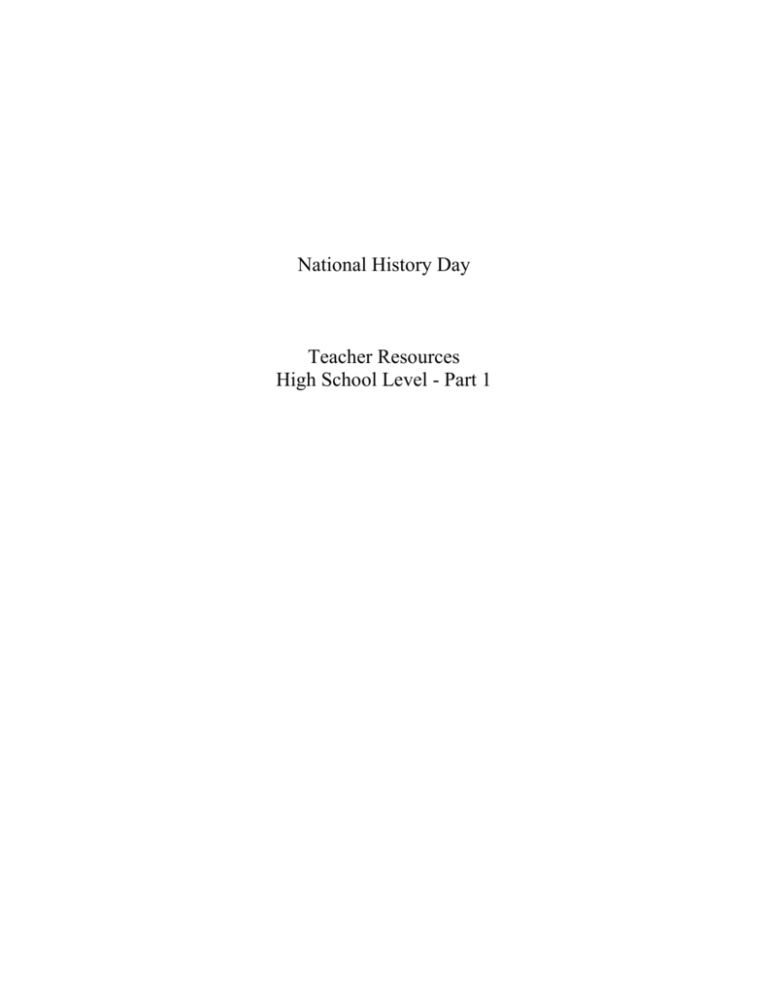
National History Day Teacher Resources High School Level - Part 1 National History Day Research Project A major course requirement is that all students complete a historical research project using the guidelines of the National History Day competition. Students may choose to complete a research paper, museum exhibit, dramatic presentation, interactive website, or documentary. Students choose to complete a project as an individual or as a group, however, groups agree to accept one grade. 2014-15 theme: Leadership and Legacy in History 2015-16 theme: Exploration, Encounter, Exchange in History Website: http://www.nhd.org/themebook.htm Step 1 – Select a topic (20 points). [Set any criteria that makes sense to your school / course / time period]. You must choose a topic that is historically important, relates to the theme of the contest, and one in which you have a genuine interest. Suggestions will be discussed in class. There are special awards for topics dealing with local or state history. Complete the entry form and submit no later than [insert date here] Step 2 – Narrow your topic. For example, the Pony Express is an interesting phenomenon that was an innovative approach to transcontinental mail service. However, the topic of the Pony Express in general is very broad. You should consider what made the Pony Express so innovative and explore its legacy to American history to focus your research. Narrowing your topic is essential to a successful History Day project! Step 3 – Research. This is the longest phase of the project. Your research is not complete until you have completed the research checklist. There are wide varieties of resources available for you to begin your quest. Begin with secondary sources. These will provide historical context, may assist you in narrowing your topic even further, and guide you toward primary sources relevant to your topic. Some helpful hints about Quality Research: Use credible sources. Experts in the field write credible sources. They are peer reviewed and fact checked. If you have questions about your source’s credibility, you need to investigate further. This is especially important when using information collected from the internet. Always complete a website evaluation before using a website. When evaluating websites keep in mind: o Who wrote, published, and maintains the site? Does it contain copyrighted material? o What is the purpose of the site? Does it contain factual information or is the content ONLY opinion? o Is it easy to navigate? NOTE: This evaluation process applies to ALL sources you plan on using for you project!!! BE CRITICAL! Step 4 - Developing an annotated bibliography. You need to develop a system to track and categorize your research. Begin by building an annotated bibliography as you research. Each source must be correctly cited and contain an annotation. For the citation, include all the relevant information you will need to direct someone else to that source: o Author or Editor o Publisher o Year of publication or copy-right o City of publication o Title of book or journal, include issue and volume numbers when applicable o Title of article o Page numbers o Hosts and URL addresses for websites The annotations should be 3+ sentences and include: 1. is the source primary or secondary? 2. what parts of the source are relevant to your topic? 3. how is the source important to your topic? Additionally, your annotated bibliography should contain sources available at the school and community libraries. You are required to do some research out of school – consider community libraries, college or community college libraries, or even resources available in your broader region [edit based on geographic location. Some teachers pair with local universities and sometimes with education students as research mentors. Access to college databases can be a very valuable experience for high school students]. Internet sources are legitimate, provided they can be authenticated. Wikipedia, about.com, and other “general knowledge” sources are not legitimate resources. NOTE: Annotated bibliographies are REQUIRED for ALL projects. Building a quality bibliography as you go will save you time and headaches later!!! Along with an Annotated Bibliography, you must develop a system to record and organize the research you are collating. Notecards are an effective tool to assist you. The same system could be replicated in Microsoft Word documents or through NoodleTools as well. It’s up to you decide which organizational system works best for you. Step 5 – Research Analysis Sheets. There are two research checkpoints built into the calendar. On a research checkpoint, you need to turn in five research analysis forms. This is an individual assignment. If you are in a group, you need to divide up the sources and turn in individual work. Each sheet needs to contain the appropriate citation and follow the instructions accordingly. The requirements shift from checkpoint 1 to checkpoint 2- read the directions carefully. First checkpoint [Insert date here] Second checkpoint [Insert date here ] Step 6 – Interviews. You need to attempt to get at least three interviews. Find the contact information on them and turn in your forms by [Insert date here]. Then, try to contact those people. Proof of an attempt to contact these people is due by [Insert date here]. Step 7 – Final product . The final product must be submitted in its entirety no later than [Insert date here]. All components, including process papers, and final annotated bibliographies, will be scored. Exhibits and performances will be scheduled and presented to the class- check the assignment sheet for the schedule. Important Dates: National History Day Regional Competition at LOCATION – DATE National History Day Affiliate Competition at LOCATION – DATE National History Day National Competition at the University of Maryland, College Park – [change date as needed] [To find the date for a North Carolina district contest near you, visit www.ncdcr.gov/historyday/Dates.aspx and click on the link in the right margin “District Contest Information.” The state and national contest dates are also listed at www.ncdcr.gov/historyday/Dates.aspx.] Step 1: Topic Proposal Form Due: ________________________ Name(s): Type of Entry: _____ Historical paper (individuals only) _____ Documentary _____Individual _____Group _____ Museum Exhibit _____Individual _____Group _____ Website _____Individual _____Group _____ Performance _____Individual _____Group [This is not a firm commitment, but they should have an idea of what they’re interested in – especially if they are a group] Proposal Description – Who / what do you want to study? Subject: Why are you interested in studying this person / event / idea? Describe why this person / event is important – explain the historical significance. Give three clear reasons why this was important to history at a local, state, national, or international level: a. b. c. So what? Why is this important enough for you to research and present? Convince me. How Do I Choose My Category? Do you have special interests or talents that lend themselves to a specific category? How can your material best be expressed? Answering the following questions may help you decide. Historical Paper 1. Do I enjoy writing? 2. Am I more comfortable expressing myself on paper rather than in front of an audience? 3. Am I trying to convey a complex idea that requires a lot of explanation? Performance 1. Do I enjoy being in front of an audience? 2. Do I like to act? 3. Can I sing or play a musical instrument? (Musical talent is not necessary, but many students incorporate music into their performances.) 4. Can my topic be expressed dramatically? Exhibit 1. Do I enjoy creating things with my hands? 2. Do I have room to keep an exhibit once I create it? 3. Do I have a way to transport my project to a contest? 4. Can I tell my story primarily through pictures and artifacts instead of words? Documentary 1. Do I have access to and enjoy working with media equipment? 2. Do I have access to editing equipment that I can operate? 3. Do I have a VCR, television, slide projector, tape recorder, computer, etc. that I can take to a contest? 4. Will my research be most clearly presented as a documentary? Websites 1. Do I enjoy working with computers? 2. Do I have access to a laptop computer to present my entry at the contest? 3. Do I have a basic knowledge about developing websites? 4. Can I effectively present my topic in a website? NHD: Choosing a Topic A. Topic Selection 1. Historical sub-fields – History is a huge and broad umbrella that includes lots of sub-branches of history. Look at the list below and choose five to cross out (that you have NO interest in) and five to circle (that you have a high interest in). political history social history military history economic history religious history cultural history diplomatic history environmental history women’s history public history history of government demographic history rural history family history ethnic history labor history urban history history of education history of the common man intellectual history 2. Time Periods / Geographic Regions – the second thing that you have to do is to narrow down some geographic locations. Based on that, choose one or two that you’d like to pursue. North America Central America Caribbean South America Pre-Columbian Pre-Columbian Pre-Columbian Pre-Columbian Exploration and Settlement Exploration and Settlement Exploration and Settlement Exploration and Settlement Founding / pre-civil war Independence movements Independence movements Independence movements Post-Civil War Twentieth century Twentieth century Twentieth century Europe Africa Asia Pacific Rim Romans, Dark/Middle Ages Pre-imperialism Pre-imperialism Pre-imperialism Early Modern Imperialism Imperialism Imperialism Imperialism Post-imperialism Post-imperialism Post-imperialism Twentieth century Modern Africa Modern Asia Modern Oceania 3. Are you thinking of working in a group? Glance at the paper of the members of your group – do you agree more than you disagree? B. Web Searching – Choose three of the links below to explore. Our Documents - http://www.ourdocuments.gov/index.php?flash=true& Look at the 100 most important documents in US history. Choose three that you think are interesting and note WHY you are interested in these documents Document…. This is interesting because…. Library of Congress - http://www.loc.gov/teachers/classroommaterials/primarysourcesets/ Click on the link above and choose two set of primary sources Primary Source Set…. This caught my attention… National Historic Landmarks - http://www.nps.gov/nhl/ Sometimes a place can inspire an idea….the National Parks Service protects historic places across the United States Ideas….. PBS History - http://www.pbs.org/topics/history/ On the menu bar across the top, choose the “topics” and choose some categories that interest you. Note your pathways and ideas in the boxes below. Ideas….. Library of Congress Timeline – http://www.loc.gov/teachers/classroommaterials/presentationsandactivities/presentations/timeline/index.html If you like to look at history chronologically…..try this Ideas…. C. If you have extra time, consider some of these…. If you’re interested in…. Exploration in North and South America…. Try…. http://www.americanjourneys.org/ http://www.history.org/history/teaching/index.cfm http://www.dohistory.org/home.html Social History http://www.ashp.cuny.edu/ Politics and government http://www.annenbergclassroom.org/ Women’s History http://www.womeninworldhistory.com/thematicunits.html A general overview of US History http://historymatters.gmu.edu/ http://chroniclingamerica.loc.gov/ http://www.digitalhistory.uh.edu/index.cfm https://www.gilderlehrman.org/ http://nhd.org/USHistoryPrimarySources.htm http://www.bne.es/es/Colecciones/ http://eudocs.lib.byu.edu/index.php/Main_Page http://centropr.hunter.cuny.edu/ http://www.preb.com/geneal2/adasj.htm http://www.loc.gov/rr/hispanic/ Colonial History World History Puerto Rican/Latino History Step 3 - Research Checklist Have you…. o Searched the school library catalog for books Searched under your subject’s name(s) Searched the name of key associates of that person or people associated with the event Searched the name of key events with which your person was associated o Searched the school’s electronic databases for articles and primary sources Searched under your subject’s name(s) Searched the name of key associates of that person or people associated with the event Searched the name of key events with which your person was associated [Ask your school librarian to reference the best electronic database sources and review how to complete advanced searches with the students] o Searched the Access database for more books [many states or larger school districts will allow for inter-library loans, making almost any book available to the student for free – just assume a 1-2 week lead time for the book to come in ] o In the school library: Searched the shelves (history and biography sections) Searched the name of key associates of that person Searched the name of key events with which your person was associated Searched the reference book shelves Searched the name of key events with which your person was associated [school librarians often know their collections best – ask them what they would put in this section] o In the classroom Searched the classroom library Searched the classroom DVD library Searched the primary source shelf and document books Searched the textbook shelf Searched the Dictionary of American Biography [again, this will vary based on your resources ] o On the Internet: Search the course website for research resources in your time period. [I began compiling a list of good sites that the kids or I found and adding to it each year. Colleagues might be able to add to it to help get you started] Google key words (you never know what you might find) Google key words (using site:edu) Google for primary sources (“Eleanor Roosevelt primary source”) Repeat process using other key words Searched the OAH Magazine of History site http://www.oah.org/pubs/magazine/ Search the American Heritage website http://www.americanheritage.com/ Search the History Net website http://www.historynet.com/ Reminder about Primary, Secondary and Tertiary Sources Primary Source-The most common definition of a primary source is that which is written or produced in the time period. Primary sources are materials directly related to a topic by time or participation. These materials include letters, speeches, diaries, newspaper articles from the time, oral history interviews, documents, photographs, artifacts, or anything else that provides first-hand accounts about a person or event. This definition also applies to primary sources found on the internet. Secondary Source- Secondary sources are usually published books or articles by authors who were not eyewitnesses or participants in the historical event or period and who base their interpretation on primary sources, research, and study. These sources provide context for a historical event. For example, high school history textbooks, biographies, retrospective newspapers and other history books about a particular topic are secondary sources. This definition also applies to secondary sources found on the internet. Tertiary Source-Tertiary sources are summaries and collections of primary and secondary sources. These sources provide ideas for topics and further investigation. Some examples are almanacs, encyclopedias, dictionaries, guidebooks, manuals, etc. Keepers of the Past: Finding the Information You Need In the search for history and those little “nuggets” of information that provide historians with insight into the past, there are times when a lot of time and patience are needed to uncover (or discover!) just the right source. Listed below are “repositories”, or places where you might find many of the resources you need for your project! However, do not limit yourself to just this list! See if you can discover and record other repositories and sources of your own! STATE RECORDS: Historic Registers Photographs Census Records Geological Survey Maps Military Records Fire Records Railroad Records HISTORICAL & CULTURAL INSTITUTIONS: Special Collections Artifacts Archaeological Site Maps Letters Government Records Newspapers Exhibits Historical Archives HOME: Albums Diaries Journals Letters Private Collections Genealogy Quilts Oral Histories Medical Records Military Records Photographs COURTHOUSE: LIBRARY: SCHOOLS: Deeds Wills Ledgers Estate Settlements Marriage Records City Directories Tax Records Genealogy Records Census Records Business Ledgers Histories Reference Works Special Collections Primary Sources Magazines Books Photographs Yearbooks Attendance Records School Board Minutes ONLINE: BUSINESSES: PLACES OF WORSHIP: Primary Sources Secondary Sources Photographs Letters Census Records Genealogy Records Newspapers Employer Newsletters Correspondence Annual Reports Photographs Historical Records Memberships Names and Dates Cemetery Records Burial Practices Inscriptions Name: _____________________________________Date: ________________ National History Day Notes 1. TYPE OF SOURCE (circle one) Primary or Secondary 2. SOURCE INFORMATION: Title / Name of Source: ________________________________________________________________ Article Title (if needed) ________________________________________________________________ Type (book, interview, etc): ____________Volume/Edition (if needed)________ Author(s)/ Editor(s): ________________________________________________ Publisher: ________________________________________________________ City, State and Year Published: ________________________________________________________________ Pages Used: _____________________________________________________ FOR WEBSITES ONLY: URL: (www) ______________________________________________________ When it was electronically published: _________________Date Used: ________ 3. NOTES FROM THE SOURCE: Type of notes: (circle all that apply): Summary paraphrase and/or quotations Name: _____________________________________Date: ________________ Quotes (p.)from article/book Why quote is important National History Day Notes __________________________________________________________________________________________ __________________________________________________________________________________________ __________________________________________________________________________________________ __________________________________________________________________________________________ __________________________________________________________________________________________ __________________________________________________________________________________________ __________________________________________________________________________________________ 4. FOR ANNOTATION What is this source about? (Don’t just explain about your topic. What is included in this source?) Describe why it helps you with your topic/project. What does if bring to your research that helps you understand your topic/prove your thesis? 5. CITATIONS Now that you are finished with this part, go to one of these websites or use an MLA citations book to properly CITE the source. YOU ARE NOT DONE with this until you have PROPERLY cited the source! Step 4 - Annotated Bibliography Instructions Annotated Bibliographies are a common practice in post-secondary research. In my opinion, it is the most important skill that you will learn here and use in your future academic career. We will work on these in preparation for your NHD project. *NOTE: A Comprehensive, student-friendly annotated bibliography guide can be found at www.nhd.org on the “Entering the Contest” page under the “Conducting Research” dropdown* Key elements of an annotated bibliography: It is called an Annotated Bibliography. Not a Bibliography, not a Works Cited. Put this in the top center and either underline or boldface the title. Primary sources are listed first, and listed in alphabetical order by the first word in the citation (excluding “a,” “an,” and “the.”) Secondary sources are listed next, and listed in alphabetical order by the first word in the citation (excluding “a,” “an,” and “the.”) **To assist you with this, you may want to create a file of Primary Sources and a file of Secondary Sources. Annotated bibliographies are double-spaced (no need for an extra line between entries). All lines after the first lines are tabbed in one tab (1/2 inch). URLs (web addresses) should NOT be hyperlinked. I know that word does this automatically. Right click on the hyperlink, and click “remove hyperlink.” For this file, I referenced an article that the class had read the week before. This allows the students to be familiar. Middle school students might need several familiar examples – maybe a book or website as well as a database article? A good annotated bibliography entry contains the following elements: Annotated Bibliography Secondary Sources Proper Title Proper Subtitle Collinson, Simon. “President or King?” History Today Nov. 2000: 9-15. eLibrary. Web. 15 Aug. 2011. <http://www.elibrary.com>. Proper Citation Format (MLA in this case) This journal article argues that the partisan conflict that developed in the 1790s and came to a head in the election of 1800 was a result of the application of the ideals of the American Revolution. Understanding the American Revolution was the defining event in the lives of the electorate, the author argues that the Republicans used this event to appeal to voters, arguing that they would be completing the “revolution of 1776.” This article helped in my research to help develop my thesis on the rise of the Republican Party as an outgrowth of the revolutionary generation. The last section should be written in PAST tense, and explain HOW you USED this source in your research. Name(s)________________________________________________________ Annotated Bibliography Instructions – Phase 1 due [Insert Date Here] Phase 1: Each individual student (regardless of whether you work alone or together) will submit an annotated bibliography with one entry on [Insert Date Here] Make sure that your entry contains: A proper title A sub-heading listing whether the source is a primary or secondary source. A properly formatted MLA citation. A properly formatted annotation. Carefully checked for proper spelling, grammar, capitalization, and conventions (use the checklists on this sheet to help you). RUBRIC FOR PHASE 1: Proper title Proper subtitle 0 1 0 1 Properly formatted citation Annotation – clear summary Annotation – usage statement Spelling, grammar, conventions 0 0 0 0 1 2 1 2 1 2 1 2 Total: ___________/10 **Please print a copy of your bibliography for submission and make sure your name is typed at the top. Name(s)________________________________________________________ Annotated Bibliography Instructions – Phase 2 due [Insert Date Here] Phase 2: Each individual will submit an annotated bibliography with two new entries (1 old entry + 2 new entries) Each group will submit an annotated bibliography with original entries + four new entries on (old entries + 4 new entries) Make sure that you: Make any and all corrections from the second round – please paper clip corrected copies on the back. Classify the entries into primary and secondary sources. Alphabetize the primary sources and alphabetize the secondary sources Carefully check for proper spelling, grammar, capitalization, and conventions. Make sure all annotations start on a clean line. RUBRIC FOR PHASE 2: Proper title 01 Proper subtitle 01 Properly alphabetized 0123 Properly formatted citations 012345 Annotations – clear summary 012345 Annotations – usage statement 012345 Spelling, grammar, conventions 012345 Name(s)________________________________________________________ Annotated Bibliography Instructions – Phase 3 due [Insert Date Here] Phase 3: Each individual will submit an annotated bibliography with at least 9 sources (minimum three primary sources) Each group will submit an annotated bibliography with at least 13 sources (minimum four primary sources) Make sure that you: Make any and all corrections from the second round – please paper clip corrected copies on the back. Classify the entries into primary and secondary sources. Alphabetize the primary sources and alphabetize the secondary sources Carefully check for proper spelling, grammar, capitalization, and conventions. Include this page on the cover for a rubric (please use a paper clip). RUBRIC FOR PHASE 3: Properly Properly formatted alphabetized citations Annotations – clear summary Annotations – usage statement Spelling, grammar, conventions 0 1 3 5 0 2 4 6 8 10 0 2 4 6 8 10 0 2 4 6 8 10 0 2 4 6 8 10 Demonstrates a variety of sources: ___________/5 Total: ___________/50 Note total number of sources below: Books Reference Sources Online database articles Websites / web articles Lectures / speeches Government documents / laws / court decisions Interviews Photographs / art Ebook Other (explain) Other (explain) Other (explain) Name(s)________________________________________________________ Annotated Bibliography Instructions – FINAL FINAL Phase: Both individuals and groups will submit an annotated bibliography that includes all research to date (including all research, research analysis, and multimedia sources.) Make sure that you: Make any and all corrections from the earlier rounds Classify the entries into primary and secondary sources. Alphabetize the primary sources and alphabetize the secondary sources Carefully check for proper spelling, grammar, capitalization, and conventions. ANNOTATED BIBLIOGRAPHY RUBRIC: Properly Properly formatted alphabetized citations Annotations – clear summary Annotations – usage statement Spelling, grammar, conventions 0 1 3 5 0 2 4 6 8 10 0 2 4 6 8 10 0 2 4 6 8 10 0 2 4 6 8 10 Demonstrates a variety of sources: ___________/5 Total: ___________/50 Note total number (___________) of sources below: Total Primary Sources: ________ Total Secondary Sources: ______ Put a * next to all NEW additions to the bibliography since the last grading phase. Books Reference Sources Online database articles Websites / web articles Lectures / speeches Government documents / laws / court decisions Interviews Photographs / art Ebook Other (explain) Other (explain) Other (explain)

